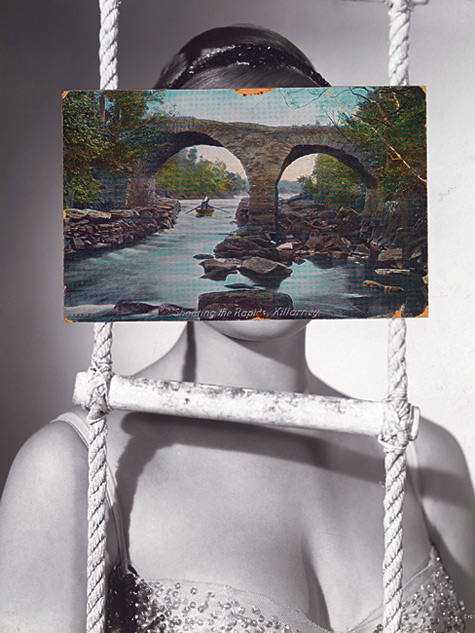
In a culture defined by an indiscriminate onslaught of images, John Stezaker’s work conveys both a fascination with their lure and a critique of their seductive power.
Using classic movie stills, vintage postcards, book illustrations and other found materials, the contemporary British artist brings new meanings to old pictures, adjusting, inverting and slicing them together to create collages that are at once captivating and unsettling, eerie and elegant, nostalgic and absurd.
This spring, the Mildred Lane Kemper Art Museum at Washington University in St. Louis will provide the only U.S. venue for the artist’s first major solo museum exhibition. Organized by the Whitechapel Gallery in London, in collaboration with Mudam in Luxembourg and the Kemper Art Museum, John Stezaker surveys his career through more than 90 works dating from the 1970s to the present.
Taken together, these works chronicle a lifelong investigation into the meanings generated by visual language and the ways those meanings are shaped by context and circumstance.
Coordinated by Karen K. Butler, assistant curator for the Kemper Art Museum, John Stezaker is roughly organized according to the artist’s use of series and various collage techniques.
Included are subtly manipulated found images, from a variety of sources; works created though excision and cutting; and found photographs layered together in startling new combinations.
Among the earliest works on view is Untitled (1977), a found black-and-white film still depicting a woman and man sitting at a piano. Stezaker initially received the print as a gift and unconsciously placed it upside down on a music stand.
“There it stayed for five years, until I decided it was a work in its own right,” Stezaker says in the accompanying catalog. “The right way up, the image shows a closed-eyed pianist, seemingly wrapped up in his own music. An admiring female, who could also stand as the muse, looks at him as he plays. When you turn it upside down, there is a kind of reversal: the muse in reflection somehow dominates the active musician, who becomes this strange sleeping figure.”
Film stills also figure prominently in Stezaker’s Marriage series. Splicing together publicity photos of classic movie stars, both male and female, Stezaker creates hybrid characters that appear both disjointed and oddly harmonious, their residual allure rendered poignant by the discrepancies between the elegantly mismatched features.
Conversely, the Dark Star series turns publicity portraits into cutout silhouettes, draining the image of celebrity and suggesting a more ambiguous presence, while the Mask series collages profiles of glamorous sitters with faded postcards of caves, hamlets and waterfalls, resulting in composite scenes that fuse portraiture with landscape.
Stezaker’s obsession with recasting old images achieves a kind of apotheosis in his Third Person Archive. Begun in 1976, this continuing series consists of hundreds of incidental figures collected from maps, atlases, geographic encyclopedias and obsolete travel illustrations dating to the 1920s and ’30s (when surrealism, an important influence on Stezaker’s work, was at a peak).
Reproduced as stamp-size miniatures, these peripheral characters, originally captured by chance or happenstance, are granted posthumous agency, their long-forgotten journeys now taking the center stage of our attention.
About the artist
Stezaker was born in England in 1949 and currently lives and works in London. He studied at the Slade School of Fine Art in London in the 1960s and has since taught at Central Saint Martins School of Art, Goldsmiths College and the Royal College of Art.
Since the 1970s, Stezaker has exhibited widely across the United Kingdom and Europe. Recent solo exhibitions include Freiburg Kunstverein (2010); Gesellschaft für Aktuelle Kunst Bremen (GAK) (2008); Rubell Family Collection, Miami (2007); Stills Gallery, Edinburgh (2007); and White Columns, New York (2006).
Major group shows include Collage: The Unmonumental Picture, New Museum, New York (2008); Tate Triennial 2006—New British Art, Tate Britain, London (2006); The British Art Show 5 (2000); and the 40th Venice Biennale (1982).
Monograph
John Stezaker is accompanied by a fully illustrated monograph, the first overview of his work on paper, published by Ridinghouse in association with the Whitechapel Gallery. Essays by Dawn Ades and Michael Bracewell, as well as a conversation between the artist and curators Daniel F. Herrmann and Christophe Gallois, place Stezaker’s work in a historical context and analyze his methodology and practice.
Mildred Lane Kemper Art Museum
The Mildred Lane Kemper Art Museum, part of WUSTL’s Sam Fox School of Design & Visual Arts, is committed to furthering critical thinking and visual literacy through a vital program of exhibitions, publications and accompanying events. The museum dates back to 1881, making it the oldest art museum west of the Mississippi River. Today, it boasts one of the finest university collections in the United States.
Support for John Stezaker is provided by James M. Kemper Jr.; the David Woods Kemper Memorial Foundation; the Hortense Lewin Art Fund; and members of the Mildred Lane Kemper Art Museum.
John Stezaker will open with a public reception at 7 p.m. Friday, Jan. 27, and will remain on view through April 23, 2012. In addition, the Kemper Art Museum will host a panel discussion with Stezaker, Butler and Michael Newman, associate professor of art history, theory and criticism at the School of the Art Institute of Chicago, at 11 a.m. Saturday, Jan. 28, in Steinberg Hall Auditorium.
Both the exhibition and the panel discussion are free and open to the public. The Kemper Art Museum is located on Washington University’s Danforth Campus, immediately adjacent to Steinberg Hall, near the intersection of Skinker and Forsyth boulevards. Regular hours are 11 a.m. to 6 p.m. Mondays, Wednesdays and Thursdays; 11 a.m. to 8 p.m. Fridays; and 11 a.m. to 6 p.m. Saturdays and Sundays. The museum is closed Tuesdays.
For more information, call (314) 935-4523 or visit kemperartmuseum.wustl.edu.